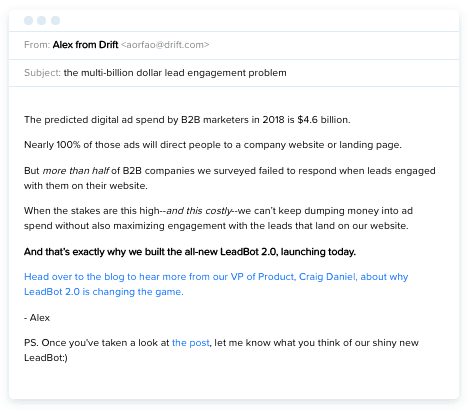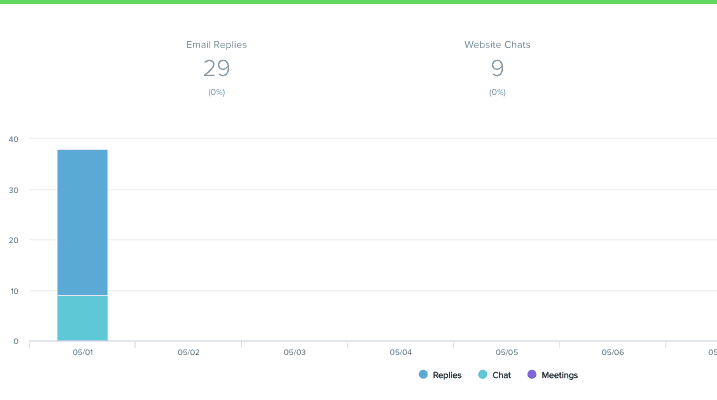
I’m obsessed with tracking email marketing performance. From delivery, bounces, and open rates to click-throughs and unsubscribes, I track multiple metrics to analyze how well email is performing as a marketing channel.
But that should come as no surprise, right? Every best-in-class demand gen team tracks those same email performance metrics.
I even went to Google and searched “best email marketing metrics” and read the top five results. Guess what? They were the exact same metrics I was already tracking.
But if there’s one thing I’ve learned since starting at Drift, it’s that there’s one email metric every demand gen team should be tracking, but few actually are:
It’s number of replies and conversations started as a result.
Confused?
Let me explain.
Yes, open rate is important because you obviously want people to read more of your emails.
And click through rate will definitely give you a baseline for engagement metrics.
But who cares if someone is clicking your email if it doesn’t end in a conversation? Those metrics are meaningless if a conversation isn’t the by-product. Because in the world of B2B, a sale starts with a conversation.
So how can you optimize your email for replies and conversations? I’m going to give you a step by step process to follow right now.
Step #1 Allow people to reply to your email.
Every day, I get tons of messages that come from email addresses like donotreply@company.com or marketing@anycompany.com. If I happen to have a question and want to reply to these emails, though, I’m completely out of luck.
That’s because most companies will send email replies to the place where conversations go to die — aka, a folder in their email inbox aptly called “marketing email replies.”
Unsurprisingly, this creates a terrible experience for prospects and customers.
So let’s change this today. Stop making it difficult for your prospects to reply to your emails once and for all and engage them in conversation. Yeah, you might get some out of office replies, but you’ll also get some conversational gold in there that you would have missed otherwise. Mine for those nuggets by leveraging real conversations with the people on your list.
Step #2 Ask people to answer a question.
I don’t expect a reply unless I ask for one. That’s why you’ll usually see me add a P.S. or a question to the end of all my emails.
Maybe you want feedback on a new launch or ideas for a webinar topic. Perhaps you just want to see if people want help setting up Drift. Ask people to reply with their answers to the questions you add at the end of an email (or the beginning), and you’ll see a huge amount of real-time feedback you wouldn’t otherwise get. This strategy has launched some pretty awesome conversations for me.
Here’s a great example.
In the email below, I’m letting people know about my colleague’s new post on the $4.6B lead engagement problem. In the P.S. I ask people about something related to that topic — LeadBot 2.0, our all-new and super smart bot launched the same day. Instead of just saying, “Hey, check out LeadBot!” I ask them for their feedback on the new feature. This prompts people to check it out and often, give me their unvarnished feedback.

Step #3 Get the right tools in place for measuring conversations.
Until now, we didn’t have the tools in place to easily track replies and conversations, so how were we supposed to optimize an email for… conversations?!
Well, there are tons of tools out there now that give you the insight you need on emails reply rates
I use Drift Email for Marketing (of course) every day and one of the coolest features is reply tracking.
Take a look ?

We got 29 replies from this one email.
I see these replies as the best opportunity to engage with potential prospects or customers. These are people who not only opened and read your email, they went out of their way to reply to you personally.
And given the crowded state of almost everyone’s inbox…that’s a big deal.
So make sure you have a tool in place that can track replies seamlessly so that you can improve reply rate with each send.
Alright. I’m going to leave you with some wisdom dropped by David Cancel that really stuck with me…hopefully it will change how you report on email marketing performance too:
“Until you have the conversation, there isn’t going to be a sale. So I don’t care about your dials or your hits, clicks, opens or link tracking — how many conversations did we have? Because if we have a sales team, we aren’t selling anything until we have a conversation. And without the conversation, we aren’t going to have the relationship. And without the relationship, there is no sale.”



